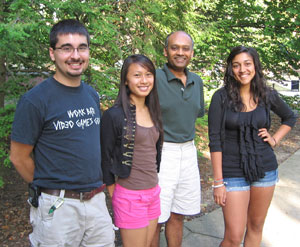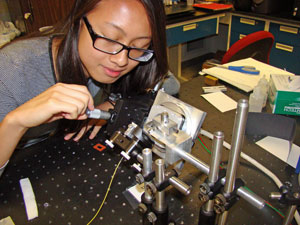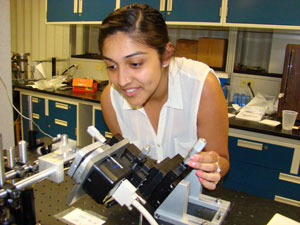www.acsprf.org
Dr. Samir Bali
 Associate Professor
Associate Professor
Department of Physics
Miami University
Grant 49348-UR6
Measurement of the Refractive Index
of Highly Turbid Media
Dr. Samir Bali studies light. Specifically, he looks at how light reflects from and refracts through turbid (cloudy, opaque) media.
Light either reflects off, or scatters throughout turbid materials, making them more difficult to analyze using traditional methods than transparent materials. This can have significant implications in multiple industries, including petroleum. Crude petroleum is a dark, turbid medium, which makes its quality difficult to assess.
“You would like to know if the sample is clean, or are there precipitates? If there are precipitates, how large are the particles, and of what nature are they?”
Dynamic Light Scattering (DLS) is a common and accurate method for conducting a petroleum analysis. DLS focuses on scattered light, and the results indicate the size of the particles that were responsible for scattering the light, thereby indicating the quality of the sample. The problem with DLS and similar methods is that, in order to use it, the medium must be diluted with water, which is invasive and changes the medium. In addition, DLS only works when the particle size is small.
 Dr. Bali and his team have developed a new method and a tool to measure the optical properties of turbid materials. The science for their tool is based on the refractive index. The traditional assumption has been that, when light passes from a denser medium (e.g., glass) into a rarer medium (e.g., air), there is a certain angle past which the light will no longer penetrate the rare medium. In other words, all of the light will reflect back—none of the light will pass into the medium. In the 1950s, scientists discovered that, in fact, the light does penetrate—just very slightly. In the time subsequent to this discovery, no methodology had emerged to utilize this slight angle-dependent penetration.
Dr. Bali and his team have developed a new method and a tool to measure the optical properties of turbid materials. The science for their tool is based on the refractive index. The traditional assumption has been that, when light passes from a denser medium (e.g., glass) into a rarer medium (e.g., air), there is a certain angle past which the light will no longer penetrate the rare medium. In other words, all of the light will reflect back—none of the light will pass into the medium. In the 1950s, scientists discovered that, in fact, the light does penetrate—just very slightly. In the time subsequent to this discovery, no methodology had emerged to utilize this slight angle-dependent penetration.
Until now, that is. Dr. Bali modeled the angle-dependence of the penetration and designed a methodology uniquely capable of analyzing the material contained within this slight depth of light penetration. His method works for small particle sizes, and preliminary data indicates it could also be successful to measuring larger particle sizes. Furthermore, his method does not require diluting the medium (as DLS does).
Importantly, Dr. Bali’s method is in situ, eliminating the need to extract samples for analysis in a laboratory. The procedure implemented by his team is non-invasive and works in real-time.
Moving forward, Dr. Bali plans to continue research into petroleum-sensing applications of his method, focusing on aviation fuel and how its optical properties vary based on wax formation at low temperature. He also plans to use his method for the modeling of high-quality diffuse reflectors for light trapping enhancement in solar cells. No viable models currently exist for the reflectance at the glass-diffuse coating interface, which remains poorly understood. In addition he hopes to expand into bio-sensing applications such as in situ particle-sizing in intravenous human nutrients, and correlating with the refractive index the crystallinity of hydrogels used for simulating human tissue.
As a member of a department that offers a terminal master’s program within a university which has doctoral programs in chemistry, geology, and the life sciences, Dr. Bali finds that his research does not qualify for many funding programs. He is especially appreciative, therefore, for the ACS PRF funding he has received. ACS PRF funding has helped to support the salaries of the Project Investigator (PI) and graduate students, as well as equipment (e.g., fiber-coupled lasers, cameras) and supplies (optics, such as prisms and wave plates, and custom-prepared turbid samples).





Dr. Samir Bali is an Associate Professor of Physics at the Department of Physics at Miami University in Oxford, Ohio. His areas of specialization include Quantum Optics, Optical Lattices, and Optical and Atomic Physics.
